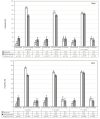Comparison of BMI derived from parent-reported height and weight with measured values: results from the German KiGGS study
- PMID: 22470314
- PMCID: PMC3315268
- DOI: 10.3390/ijerph9020632
Comparison of BMI derived from parent-reported height and weight with measured values: results from the German KiGGS study
Abstract
The use of parent-reported height and weight is a cost-efficient instrument to assess the prevalence of children's weight status in large-scale surveys. This study aimed to examine the accuracy of BMI derived from parent-reported height and weight and to identify potential predictors of the validity of BMI derived from parent-reported data. A subsample of children aged 2-17 years (n = 9,187) was taken from the 2003-2006 cross-sectional German KiGGS study. Parent-reported and measured height and weight were collected and BMI was calculated. Besides descriptive analysis, linear regression models with BMI difference and logistic regression models with weight status misclassification as dependent variables were calculated. Height differences varied by gender and were generally small. Weight and BMI were under-reported in all age groups, the under-reporting getting stronger with increasing age. Overall, the proportion for overweight and obesity based on parental and measured reports differed slightly. In the youngest age group, the proportion of overweight children was overestimated, while it was underestimated for older children and adolescents. Main predictors of the difference between parent reported and measured values were age, gender, weight status and parents' perception of the child's weight. In summary, the exclusive use of uncorrected parental reports for assessment of prevalence rates of weight status is not recommended.
Keywords: BMI; children and adolescents; height; overweight; parental reports; weight.
Figures
References
-
- World Health Organization, authors. Obesity: Preventing and Managing the Global Epidemic. World Health Organization; Geneva, Switzerland: 2000. - PubMed
-
- Moss A., Wabitsch M., Kromeyer-Hauschild K., Reinehr T., Kurth B.M. Prevalence of overweight and adiposity in German school children. Bundesgesundheitsblatt Gesundheitsforschung Gesundheitsschutz. 2007;50:1424–1431. - PubMed
-
- Bluher S., Meigen C., Gausche R., Keller E., Pfaffle R., Sabin M., Werther G., Odeh R., Kiess W. Age-specific stabilization in obesity prevalence in German children: A cross-sectional study from 1999 to 2008. Int. J. Pediatr. Obes. 2010;6:e199–e206. - PubMed
-
- Ogden C.L., Carroll M.D., Curtin L.R., Lamb M.M., Flegal K.M. Prevalence of high body mass index in US children and adolescents, 2007–2008. J. Am. Med. Assoc. 2010;303:242–249. - PubMed
-
- Kurth B.M., Schaffrath Rosario A. The prevalence of overweight and obese children and adolescents living in Germany. Results of the German Health Interview and Examination Survey for Children and Adolescents (KiGGS). Bundesgesundheitsblatt Gesundheitsforschung Gesundheitsschutz. 2007;50:736–743. doi: 10.1007/s00103-007-0235-5. - DOI - PubMed
Publication types
MeSH terms
LinkOut - more resources
Full Text Sources
Medical


